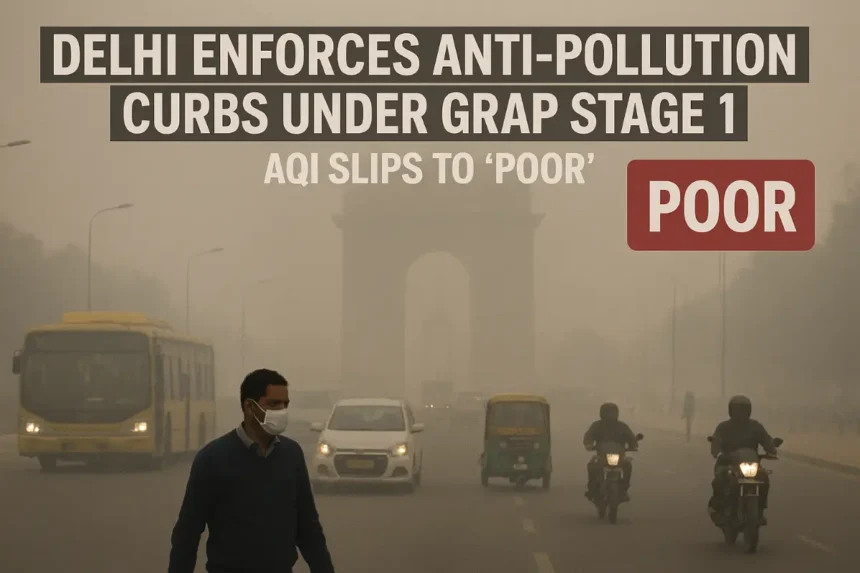As winter approaches and pollution levels start to climb, Delhi has once again stepped into its annual smog season. The Commission for Air Quality Management (CAQM) on Tuesday announced the enforcement of Stage 1 of the Graded Response Action Plan (GRAP) across Delhi and the National Capital Region (NCR).
The move came after the city Air Quality Index (AQI) reached 211, placing it firmly in the ‘Poor’ category, signaling the first official activation of anti-pollution measures this season.
CAQM Sounds the Alarm
The Sub-Committee on GRAP, during a review meeting, assessed real-time data from the Central Pollution Control Board (CPCB) and forecasts from the India Meteorological Department (IMD) and the Indian Institute of Tropical Meteorology (IITM).
“The AQI has entered the ‘Poor’ threshold, and projections indicate sustained levels in this range over the coming days due to stagnant weather conditions,” the CAQM said in its order.
This marks the first formal activation of GRAP measures for the 2025–26 winter pollution season.
What Stage 1 of GRAP Means
Under Stage 1 (‘Poor’ AQI: 201–300), several measures will be implemented by district administrations, municipal bodies, and pollution control boards across Delhi and NCR regions in Haryana, Uttar Pradesh, Rajasthan, and Punjab.
Key actions include:
- Construction Dust Control: Strict ban on labour-intensive construction work without dust mitigation systems; mandatory water sprinkling at all sites.
- Industrial and Vehicular Curbs: Intensive inspection drives for polluting industries and stricter checks on CNG compliance in public transport.
- Waste Management: Complete ban on open garbage burning and enhanced biomedical waste disposal protocols.
- Road and Power Sector: Emission audits for heavy vehicles and mandatory use of 100% piped natural gas (PNG) by power plants within a 10-km radius of Delhi.
Agencies have been instructed to maintain “strict vigil” and take immediate action to prevent the AQI from slipping into ‘Very Poor’ or ‘Severe’ categories.
Citizens Advised to Act Responsibly
Alongside government interventions, the CAQM urged citizens to contribute by adhering to the GRAP Stage 1 Citizen Charter, which recommends:
- Using public transport instead of private vehicles.
- Avoiding outdoor physical activity during peak pollution hours (especially evenings).
- Reporting violations via CAQM helpline (1800-180-1708) or its app.
The Commission also emphasized public cooperation, stating that citizen awareness remains a key factor in controlling urban pollution.
Experts Call for Structural Reforms
Environmentalists welcomed the GRAP activation but warned that short-term measures alone won’t fix Delhi pollution crisis.
“GRAP is a band-aid; without tackling stubble burning and interstate coordination head-on, we’re just postponing the inevitable smog blanket,” said Dr. Anumita Roychowdhury, Executive Director at the Centre for Science and Environment (CSE).
According to IITM high-resolution forecasting system — which boasts over 80% accuracy in predicting “Very Poor” pollution episodes — calm winds and clear skies over the coming week could trap pollutants, potentially pushing the AQI above 250 by late October.
The Road Ahead
While September 2025 saw relatively cleaner air compared to past years, data shows that Delhi pollution levels typically deteriorate sharply after Diwali, driven by firecracker emissions and crop residue burning in neighboring states.
Experts say that sustained action — including long-term air quality reforms, regional coordination, and citizen participation — will determine whether Delhi can prevent another “toxic winter.”
“Every year, Delhi fights the same battle,” said an IMD official. “Early action helps, but without addressing the root causes, winter pollution will keep coming back stronger.”









